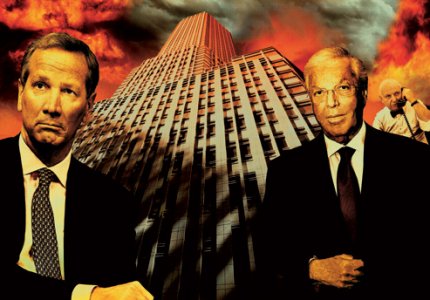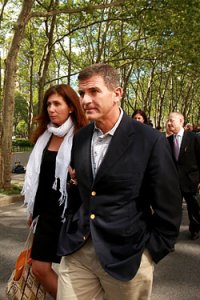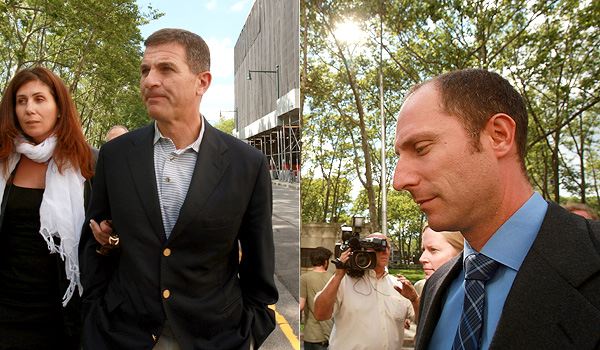Bridge Too Far
House of Cards, William D Cohen, 2009
This account of the rise and fall of Bear Stearns reads like a novel. It is even structured like a novel, opening in Part I on Wednesday March 12 2008 as Bear realizes it can’t borrow enough at the “Repo” daily market to make it through the week, starting a whirlwind of activity resulting in the sale of Bear to JP Morgan Chase (JPM) on Sunday March 16.
As the book opens, a full scale run on Bear has started with massive short selling, other firms refusing to back large trades, and massive investment withdrawals. On Thursday, fearing a systemic meltdown, the Fed, unable to lend directly to Bear, arranges to lend money to JPM who in turn will loan to Bear in an attempt to assure the markets that Bear would be able to borrow sufficiently to stay in business. The attempt fails to stop the run on Friday and unless the Fed and Treasury can negotiate a buyout, Bear will declare bankruptcy Sunday night.
This first part underlines just how shaky and unstable the financial markets are and is a good counterpart to the previously reviewed Connected: 24 Hours in the Global Economy which highlight the demise of Long Term Capital Management in 1998. Bear alone did not join the other 9 wall street firms who purchased LTCM positions to assure that LTCM’s demise didn’t blow up the entire financial system. Bear was widely resented for this refusal at the time.
The entire of wall street has become dependent for the past 30 years on short term borrowing through the so called “repo” market. Much of the borrowing is day to day so the entire of wall street is one day away from insolvency and bankruptcy. Banks have the FDIC to insure deposits, and the Fed discount window to assure access to short term money in hard times. Wall street firms have neither of these backstops. Banks are limited in the degree to which they can leverage deposits and assets; wall street is not and Bear ran itself leveraged to as much as 50 times their holdings. This means that any downturn or decline in asset value will require the borrowing of short term money or the raising of capital, at precisely the time that no one want to loan or invest.
Unknown firms and individuals were also massively shorting the stock then trading in the $60-65 range, betting that it would fall to $20-$30 within 8 trading days. Cohan believes much of the shorting was done by firms holding investments in Bear as a way of “hedging” their bets and limiting their losses if Bear continued to decline. Cohen says many believe Kyle Bass of Hyman Capital, who made a fortune betting against mortgage securities, triggered the run on Bear. To the outsider this betting both sides as a way to “hedge” the gamble of an investment seems strange but this has become a central feature of investing and dramatically increases the volatility of the system. When a firm catches a little cold, everyone jumps on to run the firm out of business by shorting its stock and can do so in a matter of days if the firm is massively leveraged.
When the extension of Federal credit did not stop the run on Bear, the Fed and Treasury went into overdrive to force the Sale of Bear by Sunday night. Only JPM was available and able to move this fast. JPM’s CEO Jamie Dimon had attempted to buy Bear a couple years earlier for Bank One and failed. The big issues were price and the unknown amount of toxic assets at Bear. The government agreed to buy $30 Billion in toxic assets but someone in government (widely believed to be Treasury Secretary Paulson, former CEO of rival Goldman Sachs and no lover of Bear) insisted on a price of $2 using a moral hazard argument that the stockholders should be punished for the problems of the firm. Unfortunately for JPM and Dimon, the negotiators – lawyers screwed up. Any purchase must be approved by a majority of the stockholders of the acquired company and this approval takes time. The agreement gave Bear up to a year to approve the sale and during this year JPM would guarantee all business and finance for Bear. Bear’s executives, reeling from the $2 price (they were led to expect at least $10) quickly realized that if they voted no they could give themselves up to a year for market conditions to approve and for a better offer to arrive, all under the umbrella of JPM protection. Dimon, when he realized his contract drafters mistake threatened to not honor the deal unless the contract was changed. He basically said, sue us, we’re not honoring this contract. It looked like Bear was headed for bankruptcy after all. In the meantime, the market also didn’t believe and $2 price and Bear stock started trading in the $10-$13 range. Dimon started buying as much stock as he could at market prices and Bear stockholders were happy to sell and avoid the $2 price until Dimon accumulated almost 50% of the shares. The vote, of course, approved the sale. The government also came down with a case of buyers remorse and renegotiated with Dimon so that JPM was liable for the the first $1 Billion loss in the $30 billion toxic asset pool.
Part II focuses on the three successive CEO s at Bear who built the company after WWII and set its culture (sharpest elbows on Wall Street). The first, Cy Lewis, was a former football pro with a volatile temper. He based his reputation on cornering railroad bonds during WWII when the government took control of the railroads to move war materials and railroad bonds fell to as low as 5 cents on the dollar. Lewis purchased all he could personally and became instantly wealthy when the bonds returned to par plus interest accrued after the war. The second, Ace Greenburg, was a canny trader who’s basic principle, learned from his father, was to never hold a loser. He also was obsessive about cost controls, at one time outlawing the purchase of paper clips and instructing secretaries to lick only one side of envelopes so they can be reused. He was a renowned philanthropist with a strange sense of humor. He paid for the remodeling of the restrooms at the Jerusalem museum and placed a plaque in each dedicated to his brother. He set up a charitable fund to provide Viagra to homeless vagrant men.
Ace was a pretty good bridge player and seems to have hired the third CEO, Jimmy Cayne, because Cayne was among the top 100 bridge players in the world. Cayne immediately used his bridge contacts, landing Larry Tisch, a huge investor for the firm. Unfortunately Tisch was Cy’s client at the time but Tisch insisted on giving his business to Jimmy. Cayne wanted to buy up NYC bonds as the city teetered on the brink of insolvency in 1976. Ace refused so Cayne went over his head to Cy who recognized the play as similar to his railroad bond purchases in WWII. The bond deal catapulted Cayne into the number two spot in the firm. Cayne eventually becomes CEO and the company went public but continued to be run like a partnership. The CEO at Bear is solely responsible for setting compensation each year and derives his power from this fact.
All three Bear CEO s had limited educations, limited business ethics, unlimited egos, and unlimited greed. They really don’t like one another. At one time Bear offered bucket shops like the one depicted in the movie Boiler Room. in return for handling trade settlement. Much of their sleazy reputation and many legal problems came from this activity though the LTCM decision didn’t help.
All three shared the same strategic goal; make as much money as you can any way you can. They developed a culture that is the antithesis of the MBA cultures at other firms. In Bear’s hiring, having an MBA is almost a viability rather than a virtue. Playing bridge well is a big plus for new hires and bridge seems to be about the only common pattern to the incompatible personalities at the firm.
Part III looks at how the once successful Bear came to find itself driven out of business in two days in mid March 2008. Quite simply they gave free reign to their very own internally grown Roque Trader (Book and Movie about how one roque trader brought down Barons). Ralph Cioffi was a much loved smart trader at Bear, but he suffered from advanced attention deficit, meaning that the firm couldn’t count on him remembering much less documenting his trading activities. To compensate, Bear assigned a team of women to follow him around and get approvals and complete the legal paperwork required to record his trading activity. They were bad at this and most trade were done without approval and the paperwork was done after the fact. The legal liabilities of this problem were never explained to the women trying to do the work.
Schwartz, Cayne, Ace as Bear Burns 
Almost half of Bear revenues come from the fixed income side of the business and Cayne organized Bear into two divisions each with its own president, Alan Schwartz, a specialist in Mergers and Acquisitions headed the division with all other business and Warren Spector headed the fixed income division. Five levels down, Cioffi is tasked with creating hedge funds to invest in mortgage backed securities. Unfortunately Cioffi runs true to form and by 2006 76% of his trades are made without prior approval but his funds are doing so well everyone covers for him. When it becomes clear that sub prime mortgages are a problem, he assures his investors verbally and in writing that his hedge funds have only 6% sub prime mortgage securities and that he is hedging these. Unfortunately his funds actually have more than 60% sub prime securities plus CDOs CDO squared and even more obscure investments and he is unable to hedge much of anything. After Bear, the parent company, became concerned that Cioffi was not getting approvals they ordered that Bear stop buying into the hedge funds. This resulted in the firm completely dropping any scrutiny the hedge funds might have received from other traders and watchdogs and risk analysts in the parent company. These hedge funds continued to generate massive revenues for Bear until fixed income accounted for 90% of total revenue. Bear stocks peaked in 2005 at $172. Only when the hedge funds turned in early 2007 did Bear come to realize that these funds contained some real problems.
Still, Bear had a year to live and get its house in order or find a buyer before the final run in March 2008. Cayne did nothing to find a serious buyer or to deal seriously with the toxic funds or to reduce leverage and increase capital. He was clearly over his head but would not step aside for a successor. As it turned out neither Schwartz (who finally became CEO weeks before the run) nor Spector would likely have been more successful in turning the firm around had they been given the time to do so. Cayne, in the middle of the crisis over the mortgage hedge funds, left town for a two week bridge tournament during which time he has unreachable. During a phone conference on March 12 dealing with the final run on the firm it was discovered Cayne had left the call to return to his bridge game. This guy was worth $1 billion at Bear’s peak in 2005 and couldn’t be bothered to interrupt his bridge game to try to save the company. Cohen mentions that Cayne reportedly pays world class bridge players $500,000 year to play with him bragging that it is like playing the pro am with Tiger Woods. These guys clearly live in a different world.
The epilogue covers the collapse of Lehman Brothers. This time David Einhorn of Greenlight Capital (another bridge player) was the major player to short the stock and start the run on Lehman. The executives at Lehman credit him with killing them. By this time, September 2008, the government had moved to take over Freddie Mac, Fanny May, and AIG. Like Bear, the Lehman crisis had to be resolved over a single weekend, only this time Merrill Lynch was in the same situation so the government had to deal simultaneously with two potentially disastrous failures, both much larger than Bear. Bank of America indicated an interest in both firms but at the last minute chose to purchase Merill. Barclays was interested in Lehman and negotiated an agreement in principle which had to be approved by British regulators. The British refused because of the unknown financial risks in Lehman’s holdings and Lehman was out of time to seek another buyer. They filed for Chapter 11. Barclays saw bankruptcy as an opportunity to pick up just those pieces of Lehman they actually wanted and did so. This saved perhaps 10,000 wall street jobs but left the toxic Lehman assets for the court to deal with.
Ralph Cioffi along with his bosses boss Mathew Tannin, who Cohen says gave performances worthy of an Oscar instead were indicted on June 16, 2008 in New York on charges of conspiracy, securities fraud, and wire fraud.
The big shortcoming in the book is that it was written by a wall street insider who assumes the reader understands wall street terms and nomenclature. A tutorial for dummies should have been included in an appendix so the reader doesn’t constantly have to go to the web to figure out what he is talking about with his wall street shorthand.


